"I want there to be less dust so I won't get sick again," said Surakrit Kiatchaipipat, or "Darwin", with enthusiasm. "Then I can go to school and play outside."
Darwin, a lively five-year-old, spoke from a specially designed room equipped with air filtration systems, anti-dust curtains, and other protective measures at his home in Bangkok's Bang Bon area. Even the toys he plays with are mostly smooth-surfaced to minimise dust accumulation.
From November to February, during the winter season, Bangkok and many parts of Thailand face a PM2.5 air pollution crisis. According to the Ministry of Public Health, over 38 million Thais live in areas where PM2.5 levels exceed safety standards. These fine particles, smaller than a human hair at less than 2.5 microns in diameter, are hazardous to adults but especially dangerous to children. Their tiny size allows them to penetrate the body and damage various systems, including vital organs. The World Health Organization (WHO) classifies PM2.5 as a carcinogen, linked particularly to lung cancer, since the particles can carry toxic substances deep into the lungs. Children are at greater risk because they breathe more rapidly than adults, increasing their exposure to pollutants.
The fifth edition of the Global State of the Air report, produced by the Health Effects Institute (HEI) in collaboration with Unicef, revealed that air pollution caused 8.1 million deaths worldwide in 2021 alone, with most attributable to PM2.5. This makes air pollution the second leading global risk factor for death, after high blood pressure. Millions more suffer from chronic illnesses as a result of pollution, placing significant burdens on healthcare systems, economies, and societies.
The report highlights that children under five are particularly vulnerable. Air pollution has been linked to a range of health issues, including premature births, low birth weights, asthma, and lung diseases. In 2021, more than 700,000 children under five died due to causes related to air pollution, including PM2.5 -- an average of 2,000 deaths per day. Air pollution is the second leading risk factor for death among young children globally, after malnutrition.
Darwin is one of the children affected. His symptoms began to appear between the ages of two and three, including difficulty breathing, swelling of the face and eyes, insomnia, and severe snoring. After multiple hospital visits, he was diagnosed with a dust allergy that left him particularly vulnerable.
Darwin's condition deteriorated, leading to inflammation of his adenoid glands, critical components of the respiratory immune system -- a crisis that required surgery. Just eight months later, doctors discovered further complications with his tonsils and blocked ear tubes, which caused fluid buildup. Without additional surgery, Darwin risked severe ear infections that could lead to hearing loss.
The infection has stolen more than just his health -- it has robbed him of many of the joys and connections of childhood. "He can't learn to swim, and we don't know when he will be able to," said his worried mother, Siregran Sakuliampaiboon. While most children his age love playing in water, Darwin must be extremely cautious when bathing due to the risk of infection.
"He couldn't play during Songkran Festival. He just has to sit by the pool during swimming lessons."
Currently, Darwin lives in a protected environment. At home, every room is equipped with air purifiers, humidity monitoring devices, and anti-dust bedding and curtains. These measures have also benefited Darwin's younger brother, who is growing up less affected by dust-related issues.
Siregran hopes that the government will take more decisive action to combat air pollution, emphasising that it affects everyone, especially children. Not all children have access to the kind of care that has been provided for Darwin.
"If we lived in a country with better air quality, Darwin could live like a normal child -- attending school, playing outside, and living a regular life without the protective bubble we've had to create for him," she said.
Darwin currently attends a private kindergarten with air-conditioned classrooms near his home. He skips swimming classes and occasionally takes sick leave if his health condition isn't stable. Siregran noted that the constant use of masks prevents children from seeing and learning from facial expressions, which are crucial for social development. Additionally, limited opportunities for outdoor activities during the winter, when pollution levels are highest, further hinder childhood development.
While it's not mandatory for kindergartens or schools to provide air-conditioned classrooms, many private schools have proactively created protected environments for their students. To address the growing air pollution crisis during winter, the Bangkok Metropolitan Administration (BMA) launched the "Dust-Free Classrooms" pilot project.
This initiative aims to provide safer learning spaces and educate students about PM2.5 pollution so they can protect themselves and share vital knowledge with their families. Currently implemented in 32 BMA schools, the programme aims to expand to all 437 schools in the near future.
In 2024, Unicef Thailand launched the #CountMeIn campaign to raise awareness about the challenges children and young people face as a result of climate change, while amplifying their voices and needs.
Unicef calls on governments, businesses, and decision-makers to protect children from the escalating climate crisis and the health effects of air pollution by improving air quality.
Key measures include supporting clean energy, creating pollution-free zones near schools and health facilities, establishing air quality monitoring systems, and making air pollution data accessible to the public.
"Our eldest son might have missed his chance, but there's still hope for other children or the next generation," Siregran said with optimism. She urged the Government to address air pollution urgently and effectively.
"Air belongs to everyone. Children are not just the future of our nation -- their good quality of life and proper development today will shape them into capable adults tomorrow."
'Dust-Free Classrooms'
Wat Wimuttayaram School in Bang Phlat, Bangkok, has become a model for educational institutions tackling air pollution by earning the "Dust-Fighting Classrooms" award. This initiative educates students about PM2.5 pollution, empowering them to protect themselves and share knowledge with their families.
Wat Wimuttayaram School is one of 32 pilot schools participating in the Dust-Free Classroom Project, a programme aimed at expanding dust-free classrooms across all 437 schools under the Bangkok Metropolitan Administration.
The school's involvement in the project began in response to heightened dust levels caused by nearby construction. Air quality monitoring apps frequently displayed red or orange alerts. Initially, the school addressed the issue by simply keeping students indoors. However, after joining the programme, it developed a comprehensive management system.
Every morning, the school announces the current dust levels to ensure students are aware of the air quality. Colour-coded flags indicating dust levels are displayed at various locations throughout the school, including on each floor of the building, to keep everyone informed of the situation.
The school's dust-prevention measures are extensive. Chalkboards have been replaced with whiteboards, desks and chairs are cleaned regularly, dust-trapping plants have been planted, and teachers and parents are encouraged to turn off car engines when parked.
For kindergarteners, air-conditioned classrooms have been provided, while elementary students are guided by air quality flags to adjust their behaviours, such as wearing masks or refraining from outdoor activities on high-dust days.
Beyond physical measures, the school also emphasises education on pollution. Morning sessions provide essential information about air quality, and rotating discussions are held in classrooms, giving students opportunities to ask questions. Dust-related knowledge is also integrated into the curriculum to foster long-term awareness and understanding.










